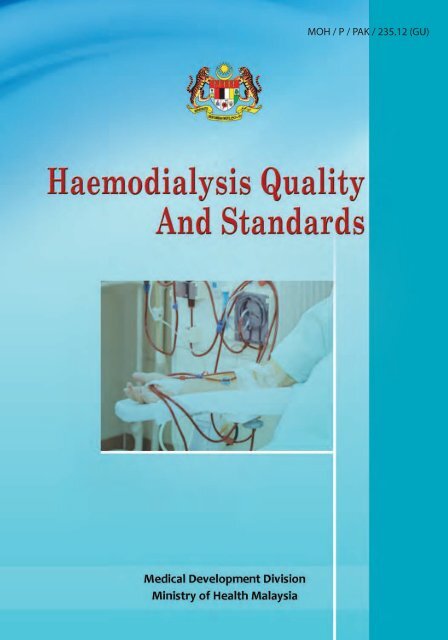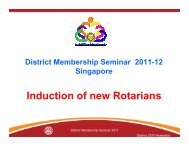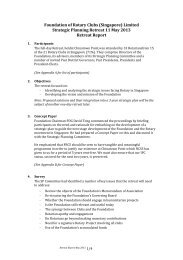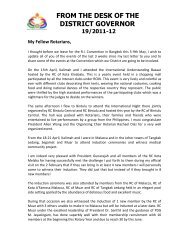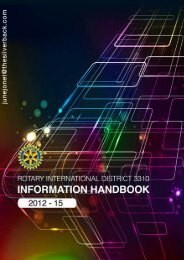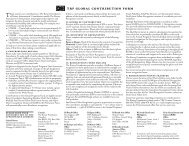haemodialysis_quality_standards - Rotary International District 3310
haemodialysis_quality_standards - Rotary International District 3310
haemodialysis_quality_standards - Rotary International District 3310
Create successful ePaper yourself
Turn your PDF publications into a flip-book with our unique Google optimized e-Paper software.
MOH / P / PAK / 235.12 (GU)
Haemodialysis Quality<br />
And Standards<br />
Medical Development Division<br />
Ministry of Health Malaysia
This document was developed by the Medical Services Unit, Medical Development Division,<br />
Ministry of Health and the Drafting Committee for Haemodialysis Quality and Standards.<br />
Published in May 2012<br />
A catalogue record of this document is available from the library and Resource Unit of the Institute<br />
of Medical Research, Ministry of Health;<br />
MOH/P/235.12(GU)<br />
And also available from the National Library of Malaysia<br />
ISBN 978-967-0399-14-0<br />
All rights reserved. No part of this publication may be reproduced or distributed in any form or by<br />
any means or stored in a database or retrieval system without prior written permission from the<br />
Director of the Medical Development Division, Ministry of Health Malaysia.
CONTENTS<br />
Page<br />
List of Appendices 5<br />
Foreword 6<br />
List of Contributors 8<br />
1 Introduction 12<br />
2 Physical Facilities 13<br />
2.1 Introduction<br />
2.2 Dialysis Room/Area<br />
2.3 Treatment/Consultation Room<br />
2.4 Resuscitation Facilities<br />
2.5 Water Treatment Room<br />
2.6 Reprocessing Room<br />
2.7 <br />
3 Equipment 15<br />
3.1 Haemodialysis (HD) Machines<br />
3.2 <br />
3.3 Water Treatment System<br />
3.4 Dialyser Reprocessor<br />
4 Dialysis Consumables 23<br />
4.1 Dialysis Concentrate<br />
4.2 Dialysers<br />
4.3 Bloodlines<br />
4.4 <br />
4.5 Clinical Waste Management<br />
5 Water Quality 25<br />
6 Human Resource 28<br />
7 Monitoring of Dialysis Patient 30<br />
8 Infection Control Measures 31<br />
9 Outcome Measures and Quality Initiatives in Dialysis 36<br />
10 Appendices 37<br />
11<br />
12<br />
References<br />
Glossary<br />
53<br />
54<br />
4<br />
Haemodialysis Quality and Standards
LIST OF APPENDICES<br />
Appendix 1:<br />
Microbial requirements for <strong>haemodialysis</strong> and related<br />
therapies.<br />
Page<br />
37<br />
Appendix 2:<br />
Maximum allowable levels of toxic chemicals and dialysis<br />
<br />
38<br />
Appendix 3: Daily R.O Water Treatment System Log Book. 39<br />
Appendix 4:<br />
<br />
Physician and Registered Medical Practitioner.<br />
40<br />
Appendix 5: 200 hours training. 41<br />
Appendix 6: Role of Person-In-Charge (PIC) and Nephrologist. 42<br />
Appendix 7: Monitoring of intra-dialytic complications. 43<br />
Appendix 8: Vascular Access Monitoring. 44<br />
Appendix 9: Dialysis Treatment Record. 45<br />
Appendix 10:<br />
Minimum laboratory investigations for chronic<br />
<strong>haemodialysis</strong> patients.<br />
46<br />
Appendix 11:<br />
Method of measurement of delivered dose of<br />
<strong>haemodialysis</strong>.<br />
47<br />
Appendix 12: Infection Control Precautions for all patients. 48<br />
Appendix 13: Recommended training on infection control in dialysis. 51<br />
Haemodialysis Quality and Standards 5
Foreword<br />
By The<br />
Director General of Health Malaysia<br />
<br />
of Health in 1994, much progress, development and advances have taken place. The numbers<br />
<br />
of the year 2010, the Ministry of Health was no longer the largest provider of <strong>haemodialysis</strong><br />
<br />
were treated at private centres, thirty percent at the Non- Governmental Organization centres<br />
<br />
<br />
patients with end stage renal disease may be seen as a healthsector success, the mushrooming<br />
of hospital based or free standing <strong>haemodialysis</strong> units all over the nation does pose a new set<br />
of challenges. There is a need to ensure that <strong>haemodialysis</strong> treatment is prescribed, initiated,<br />
maintained and terminated by trained and appropriate technical and clinical professionals so<br />
that the elements of safety and standard are adhered to.<br />
As such, this revised and updated version of the national <strong>standards</strong> and <strong>quality</strong> document in<br />
<strong>haemodialysis</strong> is timely and relevant. I hope that this document will be used as a guide by all the<br />
relevant stakeholders to ensure that the provision of <strong>haemodialysis</strong> service in all health sectors<br />
<br />
saving treatment.<br />
Dato’ Sri Dr Hasan Abdul Rahman<br />
6<br />
Haemodialysis Quality and Standards
Foreword<br />
By The<br />
Deputy Director General of Health Malaysia<br />
(Medical)<br />
In Malaysia, the evolution of <strong>haemodialysis</strong> from the short-term therapy for acute renal failure<br />
involving a handful of patients in the sixties has quickly expanded to become the most important<br />
long-term therapy for patients with end stage renal failure.<br />
While the <strong>haemodialysis</strong> service were mainly provided by the public sector in the eighties<br />
and early nineties, this is not the case now. While the density of public <strong>haemodialysis</strong><br />
centres remained static at 5 per million population (pmp) between 2005 to 2010, the private<br />
<strong>haemodialysis</strong> centres doubled from 5 pmp in 2005 to 10pmp in 2010 while the Non-<br />
Governmental Organizations (NGO) centres increased from 4 to 5 pmp over the same period.<br />
Under the Private Healthcare and Facilities Act 1998, <strong>haemodialysis</strong> services in the private<br />
and NGO sectors are subjected to licensing and monitoring so as to ensure that they are<br />
provided to meet the needs of the patients as well as delivered by taking into consideration<br />
basic requirements of safety and <strong>standards</strong>. While the contents of the Act deal with the principle<br />
and basic issues, the Ministry of Health, assisted by the members of the nephrology service has<br />
<br />
ensure that such treatments conform to the required <strong>standards</strong>. In the process of preparing this<br />
document, several public sessions were held with the participation of clinicians and technicians<br />
from both the public and private sector.<br />
As this is a national document, the <strong>standards</strong> and requirements spelt therein will apply equally<br />
to the public, private and NGO facilities.It is my sincere hope that this document will contribute<br />
to better care for patients receiving long-term <strong>haemodialysis</strong> treatment in this country.<br />
Datuk Dr Noor Hisham Bin Abdullah<br />
Haemodialysis Quality and Standards 7
LIST OF CONTRIBUTORS<br />
Editors:<br />
Datuk Dr Ghazali Ahmad<br />
Senior Consultant Nephrologist & Head of Department<br />
Hospital Kuala Lumpur<br />
Wilayah Persekutuan<br />
Dr Rosnawati Yahya<br />
Consultant Nephrologist<br />
Hospital Kuala Lumpur<br />
Wilayah Persekutuan<br />
Dr Ravindran Visvanathan<br />
Senior Consultant Nephrologist<br />
Hospital Kuala Lumpur<br />
Wilayah Persekutuan<br />
Contributors:<br />
Ministry of Health<br />
Dr Anita Bhajan Manocha<br />
Consultant Nephrologist<br />
Hospital Bukit Mertajam<br />
Penang<br />
Mr Charles Lazaar<br />
<br />
Hospital Kuala Lumpur<br />
Wilayah Persekutuan<br />
Dr Goh Bak Leong<br />
Senior Consultant Nephrologist<br />
Hospital Serdang<br />
Selangor<br />
Tuan Hj Husin Harun<br />
<br />
Hospital Kuala Lumpur<br />
Wilayah Persekutuan<br />
Dr Lawrence Hii<br />
Consultant Nephrologist<br />
Hospital Umum Sarawak<br />
Kuching, Sarawak<br />
Dr Liew Yew Fong<br />
Consultant Nephrologist<br />
Hospital Pulau Pinang<br />
Penang<br />
8<br />
Haemodialysis Quality and Standards
Dr Loh Chek Loong<br />
Consultant Nephrologist<br />
Hospital Raja Permaisuri Bainun<br />
Ipoh,Perak<br />
Dr Norleen Zulkarnain Sim<br />
Consultant Nephrologist<br />
Hospital Tengku Ampuan Rahimah<br />
Klang, Selangor Darul Ehsan<br />
Dr Ong Loke Meng<br />
Senior Consultant Nephrologist<br />
Hospital Pulau Pinang<br />
Penang<br />
Dr Shahnaz Shah<br />
Consultant Nephrologist<br />
Hospital Tengku Ampuan Rahimah<br />
Klang, Selangor Darul Ehsan<br />
Dr Tan Chwee Choon<br />
Senior Consultant Nephrologist<br />
Hospital Tengku Ampuan Rahimah<br />
Klang, Selangor Darul Ehsan<br />
Mr Tam Chong Chiang<br />
<br />
Hospital Tengku Ampuan Afzan<br />
Kuantan, Pahang Darul Makmur<br />
Dr Wan Hasnul Halimi Wan Hassan<br />
Consultant Nephrologist<br />
Hospital Raja Perempuan Zainab II<br />
Kota Bharu, Kelantan Darul Naim<br />
Dr Wong Koh Wei<br />
Consultant Nephrologist<br />
Queen Elizabeth Hospital<br />
Kota Kinabalu, Sabah<br />
Dr Zawawi Nordin<br />
Senior Consultant Nephrologist<br />
Hospital Sultanah Nur Zahirah<br />
Kuala Terengganu, Terengganu Darul Iman<br />
Haemodialysis Quality and Standards 9
ACKNOWLEDGEMENT<br />
Acknowledgement for the contribution and participation in the preparation of this document;<br />
Ministry of Health<br />
Dato’ Dr Azmi Shapie<br />
Director<br />
Medical Development Division<br />
Ministry of Health Malaysia<br />
Dr Ahmad Razid Salleh<br />
Director<br />
Medical Practice Division<br />
Ministry of Health Malaysia<br />
<br />
Deputy Director<br />
Medical Practice Division<br />
Ministry of Health Malaysia<br />
Dr Inderjeet Kaur Gill<br />
Senior Principal Assistant Director<br />
Medical Development Division<br />
Ministry of Health Malaysia<br />
Ministry of Education<br />
Prof Emeritus Datin Dr Norella Kong CT<br />
Senior Consultant Nephrologist<br />
UKM Medical Centre<br />
Kuala Lumpur<br />
AP Dr Halim Ghafor<br />
Consultant Nephrologist<br />
UKM Medical Centre<br />
Kuala Lumpur<br />
Dr Lim Soo Kun<br />
Consultant Nephrologist<br />
University Malaya Medical Centre<br />
Kuala Lumpur<br />
Malaysian Society of Nephrology<br />
Dr Wong Hin Seng<br />
President<br />
Malaysian Society of Nephrology<br />
Dr Wan Jazilah Wan Ismail<br />
Vice President<br />
Malaysian Society of Nephrology<br />
10<br />
Haemodialysis Quality and Standards
National Kidney Foundation<br />
Dato’ Dr Zaki Morad Mohd Zaher<br />
Chairman, Board of Directors<br />
National Kidney Foundation<br />
Malaysia<br />
Dr Thiruventhiran Thilagannthan<br />
Vice Chairman, Board of Directors<br />
National Kidney Foundation<br />
Malaysia<br />
Dr Lee Wan Tin<br />
Senior Consultant Nephrologist<br />
Ex-Board of Directors<br />
National Kidney Foundation<br />
Malaysia<br />
Private Health Sector<br />
Dr Prasad Menon<br />
Senior Consultant Nephrologist<br />
Sime Darby Medical Centre<br />
Selangor Darul Ehsan<br />
Dr Philip Jeremiah<br />
Senior Consultant Nephrologist<br />
Ampang Putri Hospital<br />
Selangor Darul Ehsan<br />
Dr Tan Hee Wu<br />
Senior Consultant Nephrologist<br />
Assunta Hospital<br />
Selangor Darul Ehsan<br />
Dr Fan Kin Sing<br />
Senior Consultant Nephrologist<br />
Gleneagles Medical Centre<br />
Kuala Lumpur<br />
Dr Yudisthra Ganeshadeva<br />
Consultant Nephrologist<br />
Johore Specialist Hospital<br />
Johore Bharu, Johore Darul Takzim<br />
Industry<br />
Mr Jeson Pragash<br />
Fresenius Medical Care Sdn Bhd<br />
Haemodialysis Quality and Standards 11
CHAPTER 1: INTRODUCTION<br />
1.1 Introduction<br />
This document is subdivided into several sections to cover important aspects and<br />
components of chronic <strong>haemodialysis</strong> treatment<br />
1.2 Objectives<br />
The purpose of this guideline is to ensure that <strong>haemodialysis</strong> is performed safely and<br />
is compatible with professionally accepted current practice and local or internationally<br />
recognized <strong>standards</strong>.<br />
12<br />
Haemodialysis Quality and Standards
CHAPTER 2: PHYSICAL FACILITIES<br />
2.1 Introduction<br />
There shall be adequate space and facilities for all <strong>haemodialysis</strong> activities to<br />
be performed in the <strong>haemodialysis</strong> centres and for the required volume of work,<br />
including:<br />
<br />
<br />
<br />
<br />
<br />
<br />
<br />
<br />
<br />
<br />
<br />
A storeroom with adequate space for supplies, consumables and equipment<br />
A suitable and secure area for clinical waste (Clinical Waste Area).<br />
Dialysis Room/Area<br />
Treatment/ Consultation Room<br />
Resuscitation Facilities<br />
Water Treatment Room<br />
Reprocessing Room<br />
Adequate conveniently located toilet and washbasins for the staff and patients<br />
Adequate ventilation by windows, ducts or mechanical means<br />
Janitor Room<br />
Waiting Area<br />
2.2 Dialysis Room/Area<br />
2.2.1 There shall be adequate space for dialysis machine and bed/couch/dialysis<br />
chair and such space shall not be less than 4.5 m 2 for each patient.<br />
2.2.2 HBsAg seropositive patients shall be dialysed in a separate room with<br />
dedicated machines, equipment, instruments, single use items and<br />
medications.<br />
2.2.3 Anti HCV seropositive patients shall be dialyzed in a separate room or a<br />
<br />
2.2.4 HIV seropositive patients shall be dialyzed in a separate room with dedicated<br />
machines, equipment, instruments, single use items and medications.<br />
2.3 Treatment/Consultation Room<br />
2.3.1 There shall be facilities and equipment for the treatment and care of end<br />
stage renal failure patients commensurate with the clinical procedures<br />
conducted within <strong>haemodialysis</strong> facilities.<br />
2.3.2 A <strong>haemodialysis</strong> centre providing or intending to provide minor procedures<br />
to <strong>haemodialysis</strong> patients under its care shall have a treatment room, which<br />
shall be located separate from the dialysis room/area.<br />
Haemodialysis Quality and Standards 13
2.4 Resuscitation facilities<br />
The resuscitation equipment shall include, but not limited to, cardiac monitoring<br />
<br />
laryngoscope, endotracheal tube, drugs commonly used in medical emergency and<br />
oxygen supply, which shall be easily accessible.<br />
2.5 Water Treatment Room<br />
2.5.1 There shall be a separate room for water treatment. It shall be separated<br />
from the dialysis room and all other rooms.<br />
2.5.2 Water treatment room shall be appropriately sized to house all the<br />
components of water treatment system, to facilitate staff and technicians<br />
movement for maintenance and daily log purposes.<br />
2.5.3 Treated water shall be delivered to individual <strong>haemodialysis</strong> machines<br />
through pipes made of acrylonitrile butadiene styrene (ABS), cross-linked<br />
polyethylene (PEX) or equivalent material.<br />
[Note: ABS is not compatible with bleach nor heat disinfection]<br />
2.6 Reprocessing Room<br />
2.6.1 Where dialysers are reused, a separate dialyser reprocessing room shall<br />
be available.<br />
2.6.2 This room shall only be used for dialyser reprocessing, storing of reprocessed<br />
dialysers and sterilant.<br />
2.6.3 <br />
2.6.4 There shall be a separate room for reprocessing dialysers of patients with<br />
Hepatitis B.<br />
2.6.5 There shall be a separate room for reprocessing dialysers of patients with<br />
Hepatitis C.<br />
2.6.6 For Hepatitis B & C co-infected patients, please refer to section (3.4.3)<br />
2.7 <br />
<br />
system, or<br />
If drained into a septic tank, formaldehyde shall not be used and the tank size shall<br />
<br />
14<br />
Haemodialysis Quality and Standards
CHAPTER 3: EQUIPMENT<br />
3.1 Haemodialysis (HD) machines<br />
3.1.1 HD machine shall be capable of performing conventional (diffusive) HD<br />
and preferably convective therapy.<br />
3.1.2 The machines shall be approved by regulatory authorities in USA, Europe<br />
or Japan. The machines shall also meet the conditions and regulations<br />
set up by the Director General of Health, Malaysia.<br />
3.1.3 Power supply<br />
There shall be a mechanism to ensure uninterrupted power supply to<br />
return blood from the extra-corporeal circuit in the event of power failure.<br />
3.1.4 Back-up Machine<br />
For centres running on full capacity [one (1) machine to six (6)<br />
patients], there shall be one back-up machine and<br />
<br />
For full capacity centres with more than ten (10) machines, a<br />
minimum of one back-up machine is required for every ten (10) HD<br />
machines.<br />
3.1.5 High Flux HD<br />
<br />
the dialysate shall be used.<br />
3.1.6 HD Machine Disinfection<br />
<br />
The external surfaces of the HD machines shall be disinfected after<br />
each dialysis session.<br />
<br />
Disinfection of the internal hydraulic circuit of the HD machines shall<br />
be performed after the last dialysis session of the day. However, it<br />
is preferable to disinfect after each <strong>haemodialysis</strong> session.<br />
Haemodialysis Quality and Standards 15
3.1.7 Planned Preventive Maintenance (PPM)<br />
<br />
All machines shall have a PPM and technical safety check according<br />
to manufacturer recommendations.<br />
<br />
All PPM shall be documented.<br />
3.2 <br />
3.2.1 HDF machine shall have a fully automated integrated unit that can<br />
<br />
3.2.2 <br />
<br />
<br />
<br />
<br />
<br />
least meet the ISO 23500:2011 Standards.<br />
3.3 Water treatment system<br />
3.3.1 Introduction<br />
(Appendix 1)<br />
Water treatment system is an important component in <strong>haemodialysis</strong><br />
treatment. It has to be well maintained and monitored in order to prevent<br />
any complication that may arise from chemical and microbiological<br />
contamination. Chemical contaminants may give rise to haemolysis<br />
and encephalopathy whereas, bacterial contamination may give rise to<br />
<br />
which can eventually lead to amyloidosis, suboptimal response to<br />
Erythropoiesis Stimulating Agents (ESA), malnutrition and accelerated<br />
atherosclerosis. Therefore, all centres shall adhere to the <strong>standards</strong> for<br />
maximum allowable chemical, bacterial and endotoxin contamination<br />
based on minimum requirements of ISO 23500:2011 Standards.<br />
(Appendix 1 & 2)<br />
16<br />
Haemodialysis Quality and Standards
3.3.2 Basic requirements in a water treatment system<br />
<br />
<br />
<br />
<br />
<br />
<br />
<br />
<br />
The room that houses the water treatment system shall be<br />
located in an area, which minimizes the noise and disruption to<br />
<strong>haemodialysis</strong> treatment.<br />
There shall be adequate ventilation to prevent over-heating.<br />
Floor traps shall be made available to drain excess water.<br />
Flow diagram of the water treatment system shall be displayed in<br />
the water treatment room.<br />
All water treatment components and equipment shall be clearly<br />
labelled.<br />
All columns in pre-treatment shall be opaque.<br />
Pressure gauge shall be installed before and after each component<br />
to monitor fouling of the components.<br />
Daily recording of the parameters of water treatment system shall<br />
be performed.<br />
(See Appendix 3)<br />
<br />
<br />
Daily testing for chlorine/chloramine and hardness shall be done<br />
every morning prior to starting <strong>haemodialysis</strong> treatment.<br />
All centres shall have a water treatment system that delivers water<br />
<strong>quality</strong> that meets the ISO 23500:2011 Standards.<br />
(Appendix 1 & 2)<br />
3.3.3 Components of Water Treatment System<br />
(a) Raw Water Tank<br />
<br />
<br />
<br />
<br />
<br />
Appropriate material shall be used for water storage. Examples:<br />
stainless steel-grade 316, high-density polyethylene (HDPE)<br />
Shall be covered<br />
<br />
Shall be inspected for defects and cleaned at 6 monthly intervals<br />
Shall have an appropriate capacity that is adequate to enable<br />
at least one shift of treatment to be completed if water supply is<br />
disrupted<br />
Haemodialysis Quality and Standards 17
(b) Raw water pump<br />
<br />
Two stainless steel raw water pumps are recommended<br />
(c) Multimedia Sediment Filter<br />
<br />
Backwash is required 1-3 times per week<br />
(d) Carbon Columns<br />
<br />
<br />
Empty Bed Contact Time (EBCT) shall be ten (10) minutes in total<br />
<br />
to optimise the chlorine and chloramines removal.<br />
Backwash is required one to three (1-3) times per week and the<br />
process shall be done individually for each column by adjusting the<br />
timer one to two (1-2) hours apart.<br />
(e) Softener Column<br />
<br />
<br />
Consist of polymer resin, which will be regenerated by Sodium<br />
Chloride from brine tank or equivalent<br />
Shall be placed after Carbon Column<br />
(f) Guard Filter<br />
<br />
<br />
<br />
<br />
Removes particles between 1-5 microns in diameter<br />
Safe guard the Reverse Osmosis unit pump and membranes from<br />
clogging<br />
Casing shall be opaque<br />
Filter shall be replaced as necessary or when there is pressure<br />
difference of 15 psi before and after the Guard Filter. However, a<br />
<br />
18<br />
Haemodialysis Quality and Standards
(g) Reverse Osmosis (RO) Module<br />
<br />
<br />
<br />
(Refer to Water Quality).<br />
Type of RO membrane: Spiral Wound Polyamide, TEC of<br />
Polysulfone or equivalent.<br />
The recovery rate of RO system shall be at least 50%.<br />
<br />
Standard water treatment system shall have the following<br />
parameters displayed:<br />
•<br />
•<br />
•<br />
•<br />
•<br />
•<br />
Conductivity of permeate<br />
<br />
<br />
Raw water pressure<br />
Guard-in & guard-out pressure<br />
RO (membrane) system-in & system-out pressure<br />
<br />
Water sample ports shall be available for sampling at the following<br />
points:<br />
•<br />
•<br />
•<br />
•<br />
•<br />
•<br />
•<br />
<br />
Post second carbon column<br />
Post softener column/Pre-RO module<br />
Immediate post RO module<br />
First point in the distribution loop<br />
Last point in the distribution loop<br />
Last point of the dialyzer-reprocessing loop.<br />
<br />
In the event of RO pump failure, the softened water shall be<br />
diverted into the 0.2 microns Bacterial Filter as temporary measure.<br />
However, this shall not exceed 24 hours.<br />
Haemodialysis Quality and Standards 19
(h) Treated Water Storage Tank<br />
<br />
<br />
<br />
<br />
The treated water storage tank is used primarily for dialyser<br />
reprocessing or indirect feed for dialysis.<br />
Shall be made of stainless steel (Grade 316) or High Density<br />
Polyethylene (HDPE) with a conical or bowl shaped bottom and<br />
shall drain from the lowest point of the base to ensure complete<br />
emptying of the tank.<br />
<br />
Irradiator for destruction of bacteria. There shall be an air vent with<br />
<br />
Two booster pumps are recommended for channelling the RO<br />
<br />
(i) Water Distribution Loop<br />
<br />
<br />
<br />
<br />
Treated water from the water treatment system shall be distributed<br />
to the individual dialysis stations, dialyser reprocessing stations<br />
using distribution materials and designs which will minimize or<br />
avoid microbiological contamination.<br />
Material of the distribution loop varies from Acrylonitrile butadiene<br />
styrene (ABS), cross-linked polyethylene (PEX), stainless steel<br />
(high grade 316L) or equivalent.<br />
Materials suitable for heat disinfection include cross-linked<br />
polyethylene (PEX), Polyvinylidene Fluoride and stainless steel.<br />
If ozone disinfection is used, all the above materials are suitable<br />
except PEX.<br />
20<br />
Haemodialysis Quality and Standards
(j) Disinfection of Distribution Loops<br />
<br />
<br />
<br />
A minimum ofsix (6) monthly<br />
recommendation) chemical disinfection of distribution loop<br />
including the connections to dialysis machine shall be done using<br />
peracetic acid 2-3% or chlorine dioxide especially when materials<br />
of distribution loop are not heat resistant.<br />
Weekly heat disinfection of the tank and distribution loop is<br />
recommended for a system which incorporates a heater and uses<br />
heat resistant piping.<br />
<br />
velocity of 1.5 feet per second (FPS) for direct feed system and 3.0<br />
FPS for indirect feed system.<br />
Additional disinfection may be needed in the following<br />
circumstances:<br />
(i)<br />
(ii)<br />
(iii)<br />
(iv)<br />
(v)<br />
Installation of new system<br />
Upgrading of existing system<br />
Out-break of pyrogenic reaction<br />
Breach of the closed loop system.<br />
When microbial testing of treated water reach action level<br />
(refer section 5.3.5).<br />
3.4 Reprocessing<br />
3.4.1 Dialyser Reprocessing Machine<br />
<br />
The reprocessing machine shall be approved by regulatory<br />
authorities in the USA or equivalent.<br />
<br />
The reprocessing machine shall be a fully automated integrated<br />
<br />
<br />
For reprocessing of dialyser, this shall include testing for total cell<br />
volume (TCV), membrane integrity and perform disinfection as per<br />
AAMI standard.<br />
<br />
<br />
<br />
<br />
Haemodialysis Quality and Standards 21
3.4.2 Dialyser Reprocessing Procedure<br />
<br />
<br />
<br />
<br />
<br />
<br />
<br />
The reprocessing machine shall be calibrated every morning with<br />
TCV calibration cell.<br />
The dialyser shall be cleansed of residual blood and blood products<br />
and rinsed with RO water.<br />
The dialyser shall be tested for residual membrane performance<br />
[(Total Cell Volume (TCV)] and the presence of leaks. Dialyzers<br />
with TCV
CHAPTER 4: DIALYSIS CONSUMABLES<br />
4.1 Dialysis Concentrate<br />
4.1.1 Commercially prepared dialysate<br />
Commercially prepared or ready-made dialysate shall be accompanied<br />
<br />
<br />
4.1.2 On-site dialysate preparation<br />
<br />
Due to lack of technical support and expertise, on-site dialysate<br />
preparation is currently not recommended.<br />
<br />
However, centres that currently prepare on-site dialysate shall<br />
comply with the 1SO 23500:2011 Standards and establish a<br />
Standard Operating Procedure (SOP) on dialysate preparation<br />
and dispensing.<br />
4.1.3 The dialysate packaging shall have the following information clearly<br />
labelled:<br />
<br />
<br />
<br />
<br />
Address of manufacturer<br />
Contents<br />
Concentration of electrolytes<br />
Dialysate concentration ratio<br />
<br />
Date of manufacture and expiry<br />
4.2 Dialysers<br />
4.2.1 Dialysers used for <strong>haemodialysis</strong> treatment shall be approved by<br />
regulatory authorities in USA, Europe, Japan or local equivalent.<br />
4.2.2 Dialysers made from biocompatible membrane shall be used.<br />
Haemodialysis Quality and Standards 23
4.3 Bloodlines<br />
4.3.1 Bloodlines used for <strong>haemodialysis</strong> treatment shall be approved by<br />
regulatory authority.<br />
4.3.2 Bloodlines shall not be re-used.<br />
4.4 <br />
Arterio-venous needle used for <strong>haemodialysis</strong> treatment shall be approved by<br />
regulatory authority.<br />
4.5 Clinical Waste Management<br />
The disposal of clinical waste shall follow the current Ministry of Health guidelines.<br />
24<br />
Haemodialysis Quality and Standards
CHAPTER 5: WATER QUALITY<br />
5.1 Dialysis water shall be produced by the process of Reverse Osmosis.<br />
5.2 The minimum <strong>standards</strong> indicated below is based on the ISO 23500: 2011<br />
5.3 Chemical Contaminants<br />
5.3.1 Permissible levels of chemical contaminants shall be observed and<br />
adhered to. (See Appendix 2)<br />
5.3.2 Method of Testing<br />
<br />
<br />
Chlorine and Chloramines and water hardness testing shall be<br />
performed onsite using commercially available test kits.<br />
Full analysis for chemical contaminants shall be performed by an<br />
accredited laboratory.<br />
5.3.3 Minimum Frequency of Testing<br />
<br />
<br />
Daily using commercially available test kits for chlorine and<br />
chloramines.<br />
Six (6)-monthly testing in an accredited laboratory for chemical<br />
analysis.<br />
5.3.4 Site of Testing<br />
<br />
<br />
<br />
Daily testing for Chlorine and Chloramines shall be done after<br />
each carbon column.<br />
Daily testing for hardness after softener column.<br />
Six (6)-monthly full laboratories testing for chemicals shall be<br />
done at raw water point, pre and post RO.<br />
5.3.5 Action if limits exceeded<br />
Evaluate water treatment system and rectify as necessary.<br />
Haemodialysis Quality and Standards 25
5.3.6 Record<br />
<br />
All the results shall be properly documented and made available<br />
for inspection.<br />
5.4 Microbial Contaminant<br />
5.4.1 Method of Testing<br />
<br />
<br />
<br />
Total Viable counts (Colony Forming Units) using spread plate<br />
<br />
Agar (TGEA) or equivalent.<br />
Calibrated loop technique shall not be used.<br />
The presence of pyrogen/endotoxin shall be determined using<br />
Limulus Amoebocyte Lysate (LAL) method.<br />
5.4.2 Frequency of Testing<br />
<br />
Monthly for bacterial count and endotoxin test<br />
5.4.3 Sites of Sampling<br />
<br />
Minimum sites of sampling for testing<br />
i. Post RO membrane<br />
ii.<br />
iii.<br />
iv.<br />
First point of the distribution loop<br />
End point of distribution loop (Last machine port)<br />
Reprocessing bay (for indirect feed)<br />
5.4.4 Handling of water sample<br />
<br />
<br />
Assay within 30 minutes of collection<br />
If immediate assay is not possible, refrigerate immediately at 5 o C<br />
and assay within 24 hours of collection<br />
26<br />
Haemodialysis Quality and Standards
5.4.5 Limits and Action Level<br />
Maximum Allowed<br />
<br />
<br />
CFU level < 100 CFU/ml<br />
Endotoxin level < 0.25 EU/ml<br />
Action Level<br />
<br />
<br />
CFU level > 50 CFU/ml<br />
Endotoxin Level> 0.125EU/ml<br />
(Ref: AAMI/ISO 23500: 2011)<br />
If Action Levels are observed, disinfection and retesting shall be done<br />
immediately to restore the <strong>quality</strong> into acceptable level.<br />
5.4.6 Laboratory<br />
All samples shall be sent to an accredited laboratory recognized by the<br />
Director General of Health.<br />
5.4.7 Record<br />
All the results shall be properly documented and made available for<br />
inspection.<br />
Haemodialysis Quality and Standards 27
CHAPTER 6: HUMAN RESOURCE<br />
6.1 Provision of <strong>haemodialysis</strong> facilities and services<br />
Haemodialysis services shall be provided in compliance with existing laws and<br />
regulations.<br />
6.2 Human Resource<br />
6.2.1 Person-In-Charge (PIC)<br />
The person in charge (PIC) of a <strong>haemodialysis</strong> centre shall be:<br />
<br />
<br />
<br />
<br />
A Nephrologist or<br />
A Paediatric Nephrologist or<br />
A Physician who had completed not less than 200 hours of<br />
recognized training in <strong>haemodialysis</strong> treatment and maintains an<br />
<br />
A Registered Medical Practitioner other than those listed abovewho<br />
had completed not less than 200 hours of recognized training in<br />
<strong>haemodialysis</strong> treatment before 31 Dec 2011 and maintains an<br />
<br />
(Appendix 4)<br />
6.2.2 Registered Nurse/Medical Assistant<br />
A registered nurse/medical assistant shall have at leastsix (6)<br />
months training and experience in <strong>haemodialysis</strong> and care of<br />
such patients under the supervision of registered nephrologists<br />
prior to performing <strong>haemodialysis</strong> treatment independently. An<br />
adequate number of staff is required in the facilities to ensure care<br />
and treatments are performed safely and effectively.<br />
<br />
For every six (6) dialysis patients, there shall be at least one<br />
(1) registered nurse/medical assistant with at least six months<br />
training in <strong>haemodialysis</strong> treatment and care in each shift.<br />
<br />
<br />
as recognized by the Director General of Health.<br />
<br />
There shall be at least one (1) registered nurse/medical assistant<br />
with training in cardiopulmonary resuscitation techniques in each shift.<br />
28<br />
Haemodialysis Quality and Standards
6.3 Prescribing <strong>haemodialysis</strong> treatments<br />
All <strong>haemodialysis</strong> treatment including self-care <strong>haemodialysis</strong> shall be provided<br />
under the order of:<br />
(a)<br />
A nephrologist or a paediatric nephrologist.<br />
(b)<br />
A physician with requisite training under the supervision of a nephrologist.<br />
6.4 Persons performing <strong>haemodialysis</strong> treatment<br />
6.4.1 Haemodialysis treatment and care shall be performed by:<br />
(a)<br />
A registered nurse or<br />
(b)<br />
A registered medical assistant<br />
With training and experience in <strong>haemodialysis</strong> treatment and care.<br />
6.4.2 A registered nurse/medical assistant shall have at least six months<br />
training and experience in <strong>haemodialysis</strong> and care of such patients,<br />
under the supervision of registered nephrologists prior to performing<br />
<strong>haemodialysis</strong> treatment independently.<br />
6.4.3 Nursing staff other than a registered nurse may assist in the<br />
<strong>haemodialysis</strong> treatment and care of patients but may only perform<br />
such treatment and care under direct supervision of a trained registered<br />
nurse/medical assistant.<br />
Haemodialysis Quality and Standards 29
CHAPTER 7: MONITORING OF DIALYSIS PATIENT<br />
7.1 Monitoring of patients during dialysis<br />
The dialysis treatment shall be monitored closely, with particular attention to:<br />
Any intra-dialytic complications (Appendix 7)<br />
<br />
Vital signs during dialysis: Blood Pressure, pulse & temperature<br />
Vascular Access (Appendix 8)<br />
7.2 Records of dialysis treatments<br />
Each dialysis treatment shall be recorded (Appendix 9)<br />
7.3 Long-term monitoring of dialysis patients<br />
7.3.1 Blood Investigations<br />
Blood investigations shall be done regularly at three (3) monthly<br />
intervals or more often as necessary. (Appendix 10)<br />
7.3.2 Dialysis Adequacy<br />
Dialysis adequacy shall be monitored at least every three(3)<br />
monthly.<br />
<br />
<br />
This can be calculated using Kt/V or Urea Reduction Ratio<br />
(URR). (Appendix 11)<br />
The delivered Kt/V shall be more than 1.2 or<br />
The URR shall be more than 65%.<br />
30<br />
Haemodialysis Quality and Standards
CHAPTER 8: INFECTION CONTROL MEASURES<br />
8.1 All <strong>haemodialysis</strong> centres shall have stringent measures to prevent the risk of crossinfection<br />
amongst <strong>haemodialysis</strong> patients.<br />
8.2 Management of Staff working in <strong>haemodialysis</strong> unit<br />
8.2.1 Annual screening for blood born viruses shall be performed.<br />
Staff who are HBsAg negative and:<br />
8.2.2<br />
<br />
If anti HBs antibody is 0, a full course vaccination shall be given.<br />
<br />
If anti HBs antibody
8.3.4 Vaccination Schedule<br />
<br />
A four (4) doses double-strength vaccination schedule is<br />
recommended at zero (0), one (1), two (2) and six (6) months.<br />
<br />
Serum anti-HBs Ab shall be checked one to two (1-2) months after<br />
completing the vaccination course.<br />
<br />
Those that do not develop anti-HBs Ab response (>10mIU/ml)<br />
after primary vaccination shall be re-immunized.<br />
<br />
Re-immunization consists of one to three (1-3) doses, after which<br />
if they remain negative are unlikely to respond to additional doses.<br />
8.3.5 Haemodialysis staff caring for HBsAg positive patients shall not care for<br />
Hepatitis B susceptible patients at the same shift.<br />
8.3.6 The licensee/person-in charge shall notify Ministry of Health of any<br />
Hepatitis B seroconversion.<br />
8.4 Hepatitis C: Prevention & Isolation Practice<br />
8.4.1 Patients shall be tested for anti HCV antibody:<br />
<br />
<br />
<br />
After returning from another <strong>haemodialysis</strong> facility.<br />
8.4.2 In anti HCV negative patients, serological test (ELISA) shall be repeated<br />
every three (3) months.<br />
8.4.3 <br />
8.4.4 <br />
not require repeated serological test.<br />
32<br />
Haemodialysis Quality and Standards
8.4.5 In some situations such as recent transfusion of blood/blood products or<br />
temporary dialysis in another unit, it is recommended to do monthly ALT<br />
testingfor three months,as itwill facilitate earlier detection of new HCV<br />
infections.<br />
If ALT is elevated:<br />
<br />
In patients who are anti-HCV negative, repeat anti HCV testing is<br />
warranted, however<br />
<br />
If anti HCV remains negative, HCV NAT (Nucleic Acid Testing)<br />
shall be done.<br />
8.4.6 All anti HCV positive patients shall be isolated in a separate room or<br />
<br />
separate machines, equipment and instruments.<br />
8.4.7 The licensee/person-in charge shall notify the Ministry of Health of any<br />
Hepatitis C seroconversion<br />
8.5 Hepatitis B and C co-infection<br />
8.5.1 Wherever possible, combined Hepatitis B & Hepatitis C infected patients<br />
shall be isolated.<br />
8.5.2 If the isolation facility for combined Hepatitis B & C is not available, the<br />
patient shall be dialyzed in a Hepatitis B isolation facility during the last<br />
shift.<br />
8.5.3 Single use of dialyser is mandatory.<br />
8.6 <br />
8.6.1 Patients shall be tested for anti HIV antibody:<br />
<br />
<br />
<br />
After returning from another <strong>haemodialysis</strong> facility<br />
Haemodialysis Quality and Standards 33
8.6.2 In HIV negative patients, serologic test shall be performed every three<br />
(3) months.<br />
8.6.3 HIV positive patients shall be isolated in a separate room. They shall be<br />
dialyzed using separate machines, equipment, instruments and single<br />
use items.<br />
8.6.4 Single use of dialyser is mandatory.<br />
8.6.5 The licensee/person-in charge shall notify the Ministry of Health of any<br />
cases of HIV seroconversion.<br />
8.7 Recommendations on preventing transmission of<br />
infection among chronic <strong>haemodialysis</strong> patients<br />
8.7.1 Management of potentially infected patients<br />
Patients at risk of acquiring viral infection include:<br />
<br />
All new patients with an unknown viral status<br />
<br />
All patients with negative viral status returning from another<br />
<strong>haemodialysis</strong> facility<br />
<br />
All patients with history of recent transfusion of blood/ blood<br />
products<br />
These patients are strongly recommended to be dialysed with single<br />
use dialyser and either dialysed on:<br />
<br />
A machine that is dedicated for an unknown viral status or<br />
<br />
A machine for serology negative patient at the last shift.<br />
until the patient is out of the window period for the respective infection.<br />
34<br />
Haemodialysis Quality and Standards
8.7.2 Infection Control Precautions for all patients<br />
Staff working in <strong>haemodialysis</strong> unit shall ensure implementation of, and<br />
adherence to strict infection control procedures designed to prevent<br />
cross-infection.(Appendix 12)<br />
8.7.3 Infection Control Training and Education<br />
Training and education is recommended for both staff members and<br />
patients (or their family and care givers). (Appendix 13)<br />
Haemodialysis Quality and Standards 35
CHAPTER 9: OUTCOME MEASURES AND QUALITY INITIATIVES<br />
IN DIALYSIS<br />
9.1 Reporting to National Renal Registry<br />
<br />
9.2 Recommended Standards<br />
<br />
Dialysis Adequacy (Kt/V)<br />
> 95% of patients have prescribed Kt/V >1.3<br />
> 90% of patients have delivered Kt/V >1.2<br />
OR<br />
<br />
Urea Reduction Ratio (URR)<br />
> 90%have URR> 65%<br />
9.3 Anaemia<br />
Haemoglobin (Hb)<br />
> 70% achieved Hb > 10 g/dl<br />
<br />
Ferritin<br />
> 90% achieved serum ferritin > 100 ng/ml<br />
<br />
Transferrin Saturation (Tsats)<br />
> 80% achieved t sat > 20%<br />
9.4 Mandatory Incident Reporting to Ministry of Health<br />
<br />
<br />
All hepatitis and HIV seroconversion<br />
Intra-dialytic death in chronic stable dialysis patient<br />
36<br />
Haemodialysis Quality and Standards
Appendix 1<br />
Microbial requirements for <strong>haemodialysis</strong> and related therapies<br />
Colony Forming<br />
Unit [CFU/ml]<br />
Endotoxin<br />
[EU/ml]<br />
Dialysis Water (Permeate)
Appendix 2<br />
<br />
electrolytes in dialysis water<br />
Contaminant<br />
Contaminants with documented toxicity in <strong>haemodialysis</strong><br />
Maximum Concentration (mg/l)<br />
Aluminium 0.01<br />
Total Chlorine 0.1<br />
Copper 0.1<br />
Fluoride 0.2<br />
Lead 0.005<br />
Nitrate (as N) 2<br />
Sulphate 100<br />
Zinc 0.1<br />
<br />
Electrolytes<br />
Maximum Concentration<br />
(mg/dl)<br />
(mmol/l)<br />
Calcium 2 0.05<br />
Magnesium 4 0.15<br />
Potassium 8 0.2<br />
Sodium 70 3.0<br />
Maximum allowable levels of trace elements in dialysis water<br />
Contaminants<br />
Maximum Concentration (mg/l)<br />
Antimony 0.006<br />
Arsenic 0.005<br />
Barium 0.1<br />
Beryllium 0.0004<br />
Cadmium 0.001<br />
Chromium 0.014<br />
Mercury 0.0002<br />
Selenium 0.09<br />
Silver 0.005<br />
Thallium 0.002<br />
From ISO 23500: 2011<br />
38<br />
Haemodialysis Quality and Standards
Appendix 3<br />
DAILY R.O WATER TREATMENT SYSTEM LOG BOOK<br />
Work Instruction Mon Tue Wed Thu Fri Sat Sun<br />
1. Water level in Raw Water Tank (Adequate?<br />
Please Tick)<br />
2. Timers of Pre Treatment Columns (Ensure<br />
corresponds to actual time)<br />
2.1: Multimedia column (tick)<br />
2.2: Carbon Column (tick)<br />
2.3: Softener Column (tick)<br />
3. Level of brine solution in Brine Tank<br />
(Adequate? Please Tick)<br />
4. Pressure Reading of Pre Treatment<br />
4.1: Pressure Pre Multi media Column<br />
4.2: Pressure Pre Carbon Column 1<br />
4.3: Pressure Pre Carbon Column 2<br />
4.4: Pressure Pre Softener Column<br />
4.5: Pressure of Guard Filter Inlet<br />
4.6: Pressure of Guard Filter Outlet<br />
4.7: Pressure of Pre RO Membrane<br />
4.8: Pressure of Post RO Membrane<br />
4.9: Permeate (Product) Pressure<br />
5. Permeate Flow Rate (LPM)<br />
6. Reject Flow Rate (LPM)<br />
7. Permeate Conductivity (micros/cm)<br />
8. Feed Total Chlorine (PPM)<br />
9. Feed Hardness (mg/L)<br />
Signature of Staff<br />
Please record maintenance work done:<br />
<br />
ii)<br />
Topping of vacuum salt<br />
iii) Sanitizing/ Cleaning of RO membrane<br />
iv) Sanitizing RO Water Distribution Loop<br />
Remarks:<br />
Haemodialysis Quality and Standards 39
Appendix 4<br />
<br />
Nephrologist<br />
A nephrologist is a physician who has completed a recognized post-graduate training in<br />
nephrology in an accredited centre and registered with the National Specialist Register,<br />
Academy of Medicine Malaysia.<br />
Paediatric Nephrologist<br />
A paediatric nephrologist is a paediatrician who has completed a recognized post-graduate<br />
training in paediatric nephrology in an accredited centre and registered with the National<br />
Specialist Register, Academy of Medicine Malaysia.<br />
Physician<br />
A physician is a licensed medical practitioner, who has completed a recognized post-graduate<br />
training in Internal Medicine and registered with the National Specialist Register Academy of<br />
Medicine Malaysia.<br />
Registered Medical Practitioner<br />
A Registered Medical Practitioner is a licensed medical practitioner with or without recognized<br />
post-graduate training.<br />
40<br />
Haemodialysis Quality and Standards
Appendix 5<br />
200 hours training for Physicians<br />
Objectives:<br />
<br />
<br />
<br />
maintenance <strong>haemodialysis</strong> treatment in a safe and competent manner.<br />
To improve the <strong>quality</strong> of care of <strong>haemodialysis</strong> patients.<br />
Training Module<br />
<br />
<br />
Lectures (15 hours)<br />
Practical experience (185 hours) in an accredited <strong>haemodialysis</strong> centres<br />
Eligibility<br />
<br />
Physicians who are registered with the National Specialist Register Malaysia<br />
How to apply<br />
<br />
Eligible candidates can apply through www.msn.org.my<br />
<br />
<br />
<br />
Haemodialysis Quality and Standards 41
Appendix 6<br />
Role of Person-In-Charge (who is a non-nephrologist)<br />
Responsibilities of the person in charge shall include but not limited to:<br />
<br />
<br />
Day-to-day medical care of <strong>haemodialysis</strong> patients.<br />
Ensure that each patient has a nephrologist to assume all or part of the medical care of<br />
the patient.<br />
Role of Nephrologist<br />
<br />
<br />
<br />
<br />
<br />
management.<br />
c) Advise on policies and <strong>standards</strong> for <strong>haemodialysis</strong> treatment in conformity with the<br />
requirements of the regulations and/or any nationally accepted guidelines.<br />
d) Conduct review of patients at not less than three monthly intervals. Such review<br />
shall include but not limited to clinical examination, review of blood test results, and other<br />
test results.<br />
<br />
<br />
time in order to maintain the <strong>quality</strong> of care.<br />
42<br />
Haemodialysis Quality and Standards
Appendix 7<br />
Monitoring of intra-dialytic complications<br />
During dialysis, patient shall be closely monitored for:<br />
<br />
<br />
<br />
<br />
<br />
<br />
<br />
<br />
Nausea, vomiting, and headache<br />
Hypotension or hypertension<br />
Pyrogenic reaction: chills, rigors, fever during dialysis<br />
Haemolysis<br />
Acute blood loss<br />
Air embolism<br />
Altered mental status<br />
Signs and symptoms of First Use Syndrome including chest pain, anxiety, shortness of<br />
breath, and back pain.<br />
Haemodialysis Quality and Standards 43
Appendix 8<br />
Vascular Access Monitoring<br />
Continuous assessment for signs and symptoms of vascular access complications shall be<br />
performed during each <strong>haemodialysis</strong>:<br />
<br />
<br />
<br />
<br />
<br />
<br />
<br />
<br />
<br />
<br />
Venous Pressure<br />
Thrombosis<br />
Mechanical failure<br />
Infection<br />
Skin erosion<br />
Aneurysm or pseudo aneurysm<br />
<br />
Catheters:<br />
<br />
<br />
<br />
Exit site inspection<br />
Signs of catheter thrombosis<br />
Symptoms & signs of catheter related blood stream infection.<br />
44<br />
Haemodialysis Quality and Standards
Appendix 9<br />
Date<br />
Type of dialysers<br />
No of Use<br />
Blood Flow Rate<br />
Dialysate Flow Rate<br />
Venous<br />
Pressure<br />
Heparin<br />
Blood<br />
Pressure<br />
Weight (kg)<br />
Target UF<br />
Intra-dialytic<br />
complications<br />
Medication(s)<br />
served<br />
Loading<br />
Dose<br />
Infusion<br />
Pre HD<br />
Intra<br />
Post HD<br />
Dry<br />
Pre HD<br />
Post HD<br />
IDWG *<br />
ESA**<br />
Iron<br />
Calcitriol<br />
DIALYSIS TREATMENT RECORD<br />
MONTH ____________ YEAR __________<br />
*IDWG: Inter-Dialytic Weight Gain. ** ESA: Erythropoiesis Stimulating Agents<br />
Haemodialysis Quality and Standards 45
Appendix 10<br />
Minimum laboratory investigations for chronic <strong>haemodialysis</strong><br />
patients<br />
TESTS<br />
Full blood count<br />
Iron Study:<br />
Serum Iron<br />
Serum ferritin<br />
Total Iron Binding Capacity (TIBC)<br />
Iron saturation (Tsats)<br />
Blood Urea (pre & post dialysis)<br />
Renal Function Test<br />
Liver Function Test<br />
Alanine Transaminases<br />
Alkaline phosphatase<br />
Serum albumin<br />
Calcium & phosphate<br />
FREQUENCY<br />
Every 3 monthly<br />
Every 3 monthly<br />
Every 3 monthly<br />
Every 3 monthly<br />
Every 3 monthly<br />
Consider monthly transaminases for 3 months<br />
in patients who has been dialyzing elsewhere<br />
or patients who received blood transfusion.<br />
Every 3 monthly<br />
Fasting iPTH<br />
Every 3-6 monthly<br />
Fasting Serum Lipid<br />
Every 6 monthly<br />
Blood sugar<br />
Every 3 monthly (diabetics)<br />
Every 6 monthly (non-diabetics)<br />
HbA1C (if diabetics)<br />
Virology<br />
HBs Ag<br />
Anti HB s Ab titre<br />
Anti HCV<br />
Anti HIV<br />
Every 3-6 monthly<br />
Every 3 monthly<br />
Every 6 monthly<br />
Every 3 monthly (if anti HCV neg)<br />
Every 3 monthly<br />
46<br />
Haemodialysis Quality and Standards
Appendix 11<br />
Method of measurement of delivered dose of <strong>haemodialysis</strong><br />
The delivered dose of <strong>haemodialysis</strong> in adult and paediatric patients should be measured using<br />
formal urea kinetic modelling, employing the single-pool, variable volume model. Other methods<br />
include URR (urea reduction ratio), natural log Kt/V and the Daugirdas second-generation<br />
formula<br />
Formal urea kinetic modelling provides a quantitative method for developing a treatment for<br />
<br />
to compute Kt/V using formal UKM.<br />
Various websites offer free formula for calculation of Kt/V:<br />
<br />
<br />
<br />
www.hdcn.com/calc.html<br />
www.kt-v.net/<br />
www.ureakinetic.org<br />
Kt/V natural logarithm formula<br />
Kt/V = -Ln(R - 0.008 × t)+(4 - 3.5 ×R) ×UF/W<br />
Ln<br />
R<br />
T<br />
<br />
W<br />
Natural logarithm<br />
<br />
<br />
<br />
<br />
Urea Reduction Ratio (URR)<br />
Formula for calculation of URR:<br />
URR = Predialysis Urea - Postdialysis Urea x 100%<br />
Predialysis Urea<br />
Haemodialysis Quality and Standards 47
Appendix 12<br />
Infection Control precautions for all patients<br />
(Adapted from CDC guidelines)<br />
<br />
<br />
<br />
<br />
<br />
<br />
<br />
<br />
<br />
<br />
<br />
<br />
<br />
Proper hand washing technique.<br />
<br />
at the dialysis station. Ensure a supply of clean non-sterile gloves and a glove discard<br />
container near each dialysis station.<br />
Wash hands after gloves are removed and between patient contacts, as well as after<br />
<br />
<br />
washing.<br />
If hands are not visibly soiled, use of a waterless antiseptic hand rub can be substituted<br />
for hand washing.<br />
<br />
machines, shall be disposed of, dedicated for use only on a single patient, or cleaned<br />
and disinfected before being returned to a common clean area or used for other patients.<br />
<br />
station shall not be returned to a common clean area or used on other patients.<br />
Prepare medications in a room or area separated from the patient treatment area and<br />
designated only for medications.<br />
Do not handle or store contaminated (used supplies, used equipment, blood samples,<br />
or biohazard containers) in areas where medications and clean (unused) equipment and<br />
supplies are handled.<br />
Deliver medications separately to each patient. Common carts shall not be used within<br />
the patient treatment area to prepare or distribute medications.<br />
If trays are used to distribute medications, clean them before using for a different patient.<br />
Intravenous medication vials labelled for single use, including erythropoietin, shall not be<br />
punctured more than once. Once a needle has entered a vial labelled for single use, the<br />
sterility of the product can no longer be guaranteed.<br />
Residual medication from two or more vials shall not be pooled into a single vial.<br />
48<br />
Haemodialysis Quality and Standards
If a common supply cart is used to store clean supplies in the patient treatment area,<br />
<br />
to avoid contamination with blood. Such carts shall not be moved between stations to<br />
distribute supplies.<br />
Staff members shall wear gowns, face shields, eye wear, or masks to protect themselves<br />
and prevent soiling of clothing when performing procedures during which spurting or<br />
spattering of blood might occur (e.g., during initiation and termination of dialysis, cleaning<br />
of dialyzers, and centrifugation of blood).<br />
Such protective clothing or gear shall be changed if it becomes soiled with blood, body<br />
<br />
Staff members shall not eat, drink, or smoke in the dialysis treatment area or in the<br />
laboratory.<br />
Patients can be served meals or eat food brought from home at their dialysis station. The<br />
glasses, dishes, and other utensils shall be cleaned in the usual manner; no special care<br />
of these items is needed.<br />
Establish written protocols for cleaning and disinfecting surfaces and equipment in the<br />
dialysis unit, including careful mechanical cleaning before any disinfection process. If the<br />
manufacturer has provided instructions on sterilization or disinfection of the item, these<br />
instructions shall be followed. For each chemical sterilant and disinfectant, follow the<br />
<br />
After each patient treatment, clean environmental surfaces at the dialysis station,<br />
including the dialysis bed or chair, countertops, and external surfaces of the dialysis<br />
machine, including containers associated with the prime waste. Use any soap, detergent,<br />
or detergent germicide.<br />
Between uses of medical equipment (e.g., scissors, haemostats, clamps, stethoscopes,<br />
blood pressure cuffs), clean and apply a hospital disinfectant (i.e., low-level disinfection);<br />
if the item is visibly contaminated with blood, use a tuberculocidal disinfectant (i.e.,<br />
intermediate-level disinfection).<br />
For a blood spill, immediately clean the area with a cloth soaked with a tuberculocidal<br />
disinfectant or a 1:100 dilution of household bleach (300-600 mg/L free chlorine) (i.e.,<br />
intermediate-level disinfection). The staff member doing the cleaning shall wear gloves,<br />
and the cloth shall be placed in a bucket or other leak proof container.<br />
Haemodialysis Quality and Standards 49
Published methods shall be used to clean and disinfect the water treatment and distribution<br />
system and the internal circuits of the dialysis machine, as well as to reprocess dialysers<br />
for reuse.<br />
These methods are designed to control bacterial contamination, but will also eliminate<br />
blood-borne viruses. For single-pass machines, perform rinsing and disinfection<br />
procedures at the beginning or end of the day.<br />
For batch re-circulation machines, drain, rinse, and disinfect after each use. Follow the<br />
same methods for cleaning and disinfection if a blood leak has occurred, regardless of the<br />
type of dialysis machine used.<br />
<br />
the recommendations.<br />
Venous pressure transducer protectors shall be used to cover pressure monitors and shall<br />
be changed between patients, not reused. If the external transducer protector becomes<br />
<br />
<br />
after the treatment is completed and check for contamination. This includes inspection for<br />
possible blood contamination of the internal pressure tubing set and pressure sensing port.<br />
If contamination has occurred, the machine must be taken out of service and disinfected<br />
using either 1:100 dilution of bleach (300--600 mg/L free chlorine) or a commercially<br />
available, EPA-registered tuberculocidal germicide before reuse.<br />
Housekeeping staff members in the dialysis facility shall promptly remove soil and<br />
potentially infectious waste and maintain an environment that enhances patient care.<br />
All disposable items shall be placed in bags thick enough to prevent leakage. Wastes<br />
generated by the <strong>haemodialysis</strong> facility might be contaminated with blood and shall be<br />
considered infectious and handled accordingly.<br />
50<br />
Haemodialysis Quality and Standards
Appendix 13<br />
Recommended training on Infection Control in dialysis<br />
(Adapted from CDC guidelines)<br />
Staff Training<br />
Training and education for all employees at risk for occupational exposure to blood shall be<br />
provided at least annually, given to new employees before they begin working in the unit, and<br />
documented. At a minimum, they shall include information on the following topics:<br />
<br />
<br />
<br />
<br />
<br />
<br />
<br />
<br />
<br />
<br />
Proper hand hygiene technique;<br />
Proper use of protective equipment;<br />
Modes of transmission for blood borne viruses, pathogenic bacteria, and other<br />
microorganisms as appropriate;<br />
Infection control practices recommended for <strong>haemodialysis</strong> units and how they differ from<br />
Standard Precautions recommended for other health-care settings;<br />
Proper handling and delivery of patient medications;<br />
Rationale for segregating HBs Ag positive patients with a separate room, machine,<br />
instruments, supplies, medications, and staff members;<br />
Proper infection control techniques for initiation, care, and maintenance of access sites;<br />
Housekeeping to minimize transmission of microorganisms, including proper methods to<br />
clean and disinfect equipment and environmental surfaces; and<br />
Centralized record keeping to monitor and prevent complications, including routine<br />
serologic testing results for HBV and HCV, hepatitis B vaccine status, episodes of<br />
bacteraemia and loss of access caused by infection, and other adverse events.<br />
Records of surveillance for water and dialysate <strong>quality</strong> shall also be maintained.<br />
Haemodialysis Quality and Standards 51
Patient and Family Member Training<br />
Training and education of patients (or family members for patients unable to be responsible for<br />
their own care) regarding infection control practices shall be given on admission to dialysis and<br />
at least annually thereafter and shall address the following topics:<br />
<br />
<br />
<br />
Personal hygiene and hand washing technique;<br />
Patient responsibility for proper care of the access and recognition of signs of infection,<br />
which shall be reviewed each time the patient has a change in access type; and<br />
Recommended vaccinations<br />
52<br />
Haemodialysis Quality and Standards
References<br />
1 <br />
<strong>haemodialysis</strong> and related therapies. <strong>International</strong> Organization for Standardization<br />
2 Centers for Disease Control and Prevention. Recommendations for preventing<br />
transmission of infections among chronic <strong>haemodialysis</strong> patients. MMWR 2001; 50 (No<br />
RR-5): 1-43<br />
3 Centers for Disease Control and Prevention: Infection Control Requirements for Dialysis<br />
- MMWR<br />
August 15, 2008 / 57(32); 875-876<br />
Haemodialysis Quality and Standards 53
GLOSSARY<br />
AAMI<br />
ABS<br />
ALT<br />
ANSI<br />
CFU<br />
EBCT<br />
ELISA<br />
ESA<br />
EU<br />
FPS<br />
GMP<br />
Hb<br />
HbA1C<br />
HBs Ab<br />
HBs Ag<br />
HCV<br />
HD<br />
HDF<br />
HDPE<br />
HIV<br />
IDWG<br />
iPTH<br />
ISO<br />
LAL<br />
NAT<br />
PEX<br />
PIC<br />
PPM<br />
RIBA<br />
RO<br />
SOP<br />
TCV<br />
TGEA<br />
TIBC<br />
UF<br />
Association for the Advancement of Medical Instrumentation<br />
Acrylonitrile butadiene styrene<br />
Alanine Transferase<br />
American National Standards Institute<br />
Colony Forming Units<br />
Empty Bed Contact Time<br />
Enzyme-linked immunosorbent assay<br />
Erythropoiesis Stimulating Agents<br />
Endotoxin unit<br />
Feet per second<br />
Good Manufacturing Practice<br />
Haemoglobin<br />
Haemoglobin A1C<br />
Hepatitis B surface Antibody<br />
Hepatitis B surface Antigen<br />
Hepatitis C Virus<br />
Haemodialysis<br />
<br />
High Density Polyethylene<br />
<br />
Interdialytic Weight Gain<br />
Intact Parathyroid hormone<br />
<strong>International</strong> Organization for Standardization<br />
Limulus Amoebocyte Lysate<br />
Nucleic Acid Test<br />
Cross linked Polyethylene<br />
Person In Charge<br />
Planned Preventive Maintenance<br />
Recombinant immunoblot assay<br />
Reverse Osmosis<br />
Standard Operating Procedure<br />
Total cell volume<br />
Trypton Glucose Extract Agar<br />
Total Iron Binding Capacity<br />
<br />
54<br />
Haemodialysis Quality and Standards
UKM<br />
URR<br />
Urea Kinetic Modelling<br />
Urea Reduction Ratio<br />
For the purpose of this standard, the auxiliary verb:<br />
<br />
<br />
<br />
“shall” means that compliance with a requirement or a test is mandatory for compliance with<br />
this standard;<br />
“should” means that compliance with a requirement or a test is recommended but is not<br />
mandatory for compliance with this standard;<br />
“may” is used to describe a permissible way to achieve compliance with a requirement or<br />
test.<br />
Haemodialysis Quality and Standards 55
MINISTRY OF HEALTH MALAYSIA<br />
MEDICAL DEVELOPMENT DIVISION<br />
Block E1, Parcel E, Federal Government Administrative Centre,<br />
62590 Putrajaya, Malaysia.<br />
Tel : 603-8883 1047 Fax : 603-8883 1427<br />
http://www.moh.gov.my


